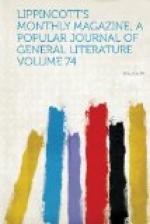Early in October, 1872, a cable despatch from Paris appeared in all the dailies, announcing that fifty thousand pilgrims were then journeying through France toward Lourdes. Their object was to assemble at the grotto of Massabielle to pray for the salvation and regeneration of France, so lately desolated by war. A large proportion of the pilgrims came from Paris, where their journey had been inaugurated by services at Notre Dame des Victoires. Indeed, it may be said that their entire journey was one long religious service, for litanies were chanted unceasingly upon the route. The grand service at the grotto took place October 6th, when five bishops conducted mass and vespers at five altars reared among the rocks; and other services were conducted at numerous chapels and shrines among the mountains for miles around by various pilgrim priests. A sermon was delivered to the great host by the bishop of Tarbes, the subject being the disasters of the nation. He closed by exhorting them to patriotism. Raising his arms to the multitude, he asked, “Will you promise to serve and love your country as I mean?”
“Yes! yes! yes!” answered the vast host in thunderous response.
“Will you cry ‘Vive la France!’ as children should who have been nurtured from the breast of a cherishing mother?”
“Vive la France!” resounded from rock and valley.
Then turning toward the statue of the Virgin, the bishop cried, “Vive the Church, the Rock of Ages!” Again the mighty voice of the crowd responded, and with the final cry of “Vive the Holy Father, Pius IX.!” the assemblage broke up.
Probably there were no scenes incidental to the pilgrimage more imposing than its processions, formed in the public square of Lourdes. One of them was a mile long, and the van had entered the meadow before the rear had left the square. It was composed of people of all classes, who sang hymns as with one mighty voice. It bore banners of violet, green, rose, blue and other colors, magnificently decorated with gilding, paintings and embroidery. These banners numbered nearly three hundred, and came from various parts of the country. Even far-off Algeria was represented. The banner of Alsace and Lorraine was in mourning, and was borne by girls in white. As it passed many persons pressed forward to kiss its hanging tassels. The banner from Nantes was so profusedly embellished with gold and other decorations that six strong men labored to support it; and those from Paris, Bordeaux, Rheims, Lille, etc. were not greatly inferior to it in elegance. The sun shone brightly, and with the grandeur of the banners and the pomp of the prelates in their rich sacerdotal robes formed a scene of indescribable splendor.




